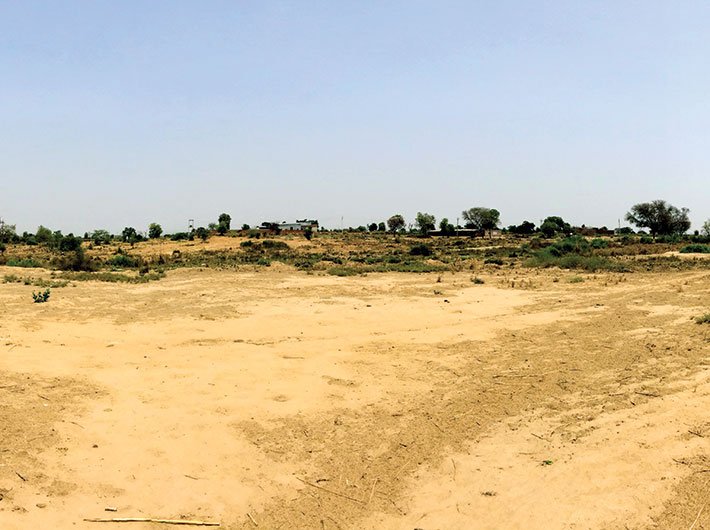NHAI has a noble mission of transplanting, instead of cutting, trees while expanding highways. A visit to Runakta in UP shows much more remains to be done to fight climate change
After cruising on the Yamuna Expressway for over an hour, I reach Runakta, a small village on the outskirts of Agra city. Here, I was told, the National Highways Authority of India (NHAI) has created a mini forest. This is an innovative initiative in two ways. Firstly, it is conservation of nature: the trees that come in the way of the widening of the highways are not cut, but transplanted. Secondly, the trees thus saved help in countering the adverse effects of the highway construction activity itself. The new mini forest would absorb the earth-heating elements – called the greenhouse gases (GHGs) – which would get released in copious amounts in the laying of, in this case, National Highway 2 between Delhi and Kolkata. The highway, quite close to the village, is part of India’s thrust on infrastructure.
Runakta, then, should now have in its vicinity a forest of 951 big trees which, instead of being axed, were to be relocated by the end of 2015, with more trees to come this year. I was expecting to be in the middle of a lush green forest at the end of a journey through the barren expressway.
Bhagwan Das, an official of the Uttar Pradesh forest department, is waiting to show me around the place. He takes me on the road cutting through the village.
I am confused when he tells me that we have reached our destination. Before me is a dusty patch of land, dotted with some fresh and many dying trees, which had been replanted as part of the green drive by the NHAI.
The Runakta green belt can come in handy for India’s ambitious pledge to the world – that it will reduce GHG emissions by 33-35 percent of its GDP by 2030. In its intended nationally determined contributions (INDC) submitted to the UN, India has pledged to create an additional carbon sink (that is, forest, soil and ocean; basically anything that absorbs more carbon than it releases) of 2.5-3 billion tonnes of carbon dioxide through additional tree cover. The pledge is of particular significance in countering climate change and saving the earth as India and China are expected to emerge as the largest emitters of the GHGs in the coming years.
The government has earmarked Rs 41,000 crore to expand the forest cover, under the compensatory afforestation fund bill (passed by the Lok Sabha this year and pending in the Rajya Sabha).
Das, a local resident in his late thirties, explains the story of tree plantation. A year ago he and other field workers and officials of the forest department came to know that they were tasked with the job of translocating 951 trees from the highway to Runakta. This was challenging work for the department, especially because none of them had transplanted a big tree before. Das and other officers were to oversee the work of ‘scalers’ who would carefully remove the trees from the ground with roots and other field workers who would transport the trees.
The department identified 951 trees of Ficus variety – Sheesham, Banyan, Peepal, Pilkhan, Amaltas, and Gulmohar – which were to be excavated with utmost care and transplanted in the dusty patch of Runakta.
“We started the process in December 2014. And as of now only 428 trees have been replanted,” Das says.
He wants to show me the ‘forest’ that he and his colleagues have created. To me, however, it is not more than a dusty patch dotted with stubs of the dead or the dying trees interspersed with a few green ones.
“Out of all the trees that you see here, many have been destroyed by termites,” he says apologetically. He adds that some 68 trees including those of Sheesham, Peepal, Pakhar and Kanji have not survived. “We use disinfectants but often the transplant takes time and trees are already dead by the time we replant them. We are doing our best and hoping the remaining ones will be saved,” Das says.
Das recalls that initially there was indeed a lot of excitement about this project. “Our department won a lot of accolades. We were seen as saviours of trees,” he reminisces.
However, within a year, Das and his colleagues were witnessing trees dying.
In the meantime, a tractor has entered the dusty patch. Madan, the driver, a local in his twenties, works for a contractor who looks after the trees. He is worried about the pumping set with which he draws the underground water for the trees as it had stopped working that morning.
I ask him how they had prepared the land to receive the trees. “We dug up the field for these trees only 10 days before they were transplanted. We also sprayed disinfectants for two days,” he explains.
However, as per norms, the replantation should be done only after testing the land for a particular plant for a minimum of three months. Das says, “We had informed them [the higher-ups in the forest department] that this land was infested with termites but they told us to mind our work and continue with transplantation work.
“Now if we tell them again about it, we know that they won’t care. We will certainly take care of the trees but since nothing is being done they will automatically die after sometime.”
Das also feels the trees were damaged at the time of being uprooted. “We don’t have big machines for uprooting the trees; we have only JCBs [used for excavating earth and rocks at construction sites]. Smaller trees are uprooted manually,” he says.
He, however, quickly adds, “Sometimes, their root ends are damaged, making them incapable of sucking nutrients from the soil after being transplanted. But that’s rare.”
It seems the transplantation was started in December 2014, and it continued till the summer of 2015. In fact, summer is not considered a good time for tree transplantation. Das admits the trees transplanted during rains and summers are at a higher risk of dying.
* * *
In New Delhi earlier this year, the NHAI had called a meet of experts from India and abroad to discuss the best management practices of transplanting trees on the highways. Views and experiences narrated there were quite in contrast to the picture on the ground in Runakta.
Ong Chye Lye, director, Anika Megah (M) Sdn Bhd – a Malaysian firm that provides forestry services, offered many a tip on transplantation. He said relocating a tree, unlike shifting soil or a rock, needs specific skills and equipment. “In Malaysia, we use machines like ‘Big John’ for digging and planting trees on other sites. This way there is no damage to the roots. Cranes cannot do this.” He said India needs to use such machines instead of improvising JCBs – as was done at Runakta.
His presentation was followed by a slide show by a team of the Gujarat forest department. To the amusement of all present, it showed JCB machines rooting out trees for transplantation.
At this Ashok Dixit, conservator of forests, Varanasi, quipped: “We can clearly see from the slideshow that the machines we use in India are a cheap duplication of Big John. Why are we lacking here? We have funds; we just need to channelise our resources in a more efficient manner.”
Coming to the costs of transplantation, it became clear that the government was yet to lay down norms. “In Runakta, the UP forest department was asking for Rs 1.5-2 lakh per tree for translocation, but we settled for Rs 60,000-70,000, which is also a very huge amount,” said S Mukhopadhyay, manager, finance and accounts, NHAI.
While an NHAI document says that the maximum cost of relocation for the largest tree should be around Rs 25,000-35,000, Mukhopadhyay says his estimates also include cost of testing of soil and field visits.
“About 10 percent of transplanted trees have to be uprooted again due to change in road designs, because of which we are not able to water the trees,” said Sanjeev Rane of Drip Drop Drizzle, a Pune-based company that undertakes transplantation.
Rane said that India needs a dedicated body of experts which would keep a check on quality of work on transplantation sites and also train the work force of transplanters. “A lot of attention should be given to the process of uprooting, since most of the time, the roots are damaged causing ultimate death of the transplanted trees.” Unless this is done, “it’s a waste of time and money”.
A senior officer of the NHAI, speaking on condition of anonymity, went to the root cause of it all. “Transplantation does not synchronise with the highway construction work. It’s something we don’t recommend,” he said. He, however, admitted that since India has to achieve a certain carbon sink target by 2030, the NHAI has to do it even though there are many areas of concern which need to be addressed by the government.
He also admitted to the high mortality rate of the transplanted trees as was the case in Runakta. “As far as our experience goes, the survival rate is not more than 45-50 percent.”
Talking of Runakta, he said when the work of uprooting a tree and laying of road goes side by side, many a time, the latter takes precedence over the former. In the process, the tree transplantation gets delayed. “If during this process, the tree does not get any moisture it is sure to die.”
sakshi@governancenow.com
(The article appears in the August 1-15, 2016)

